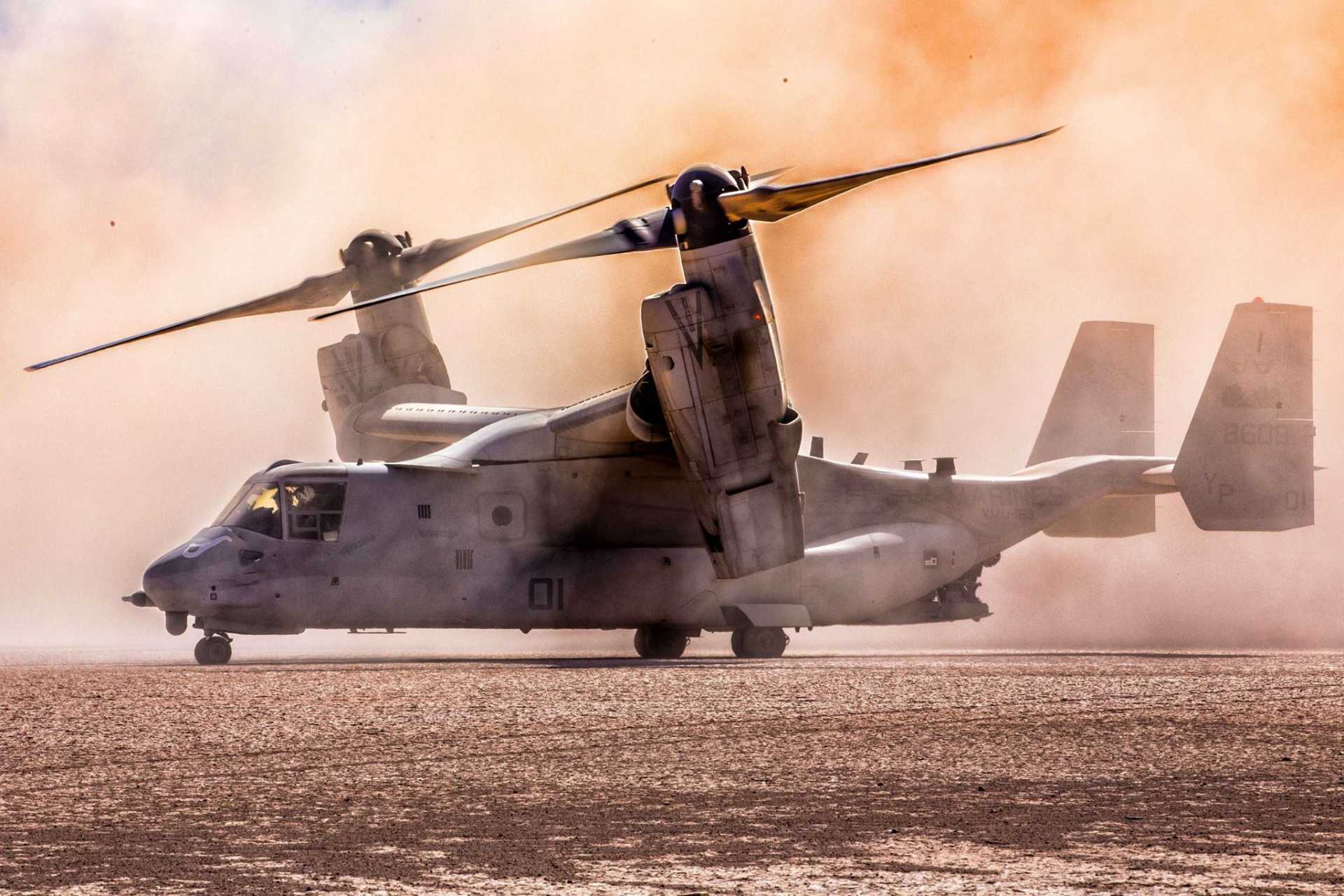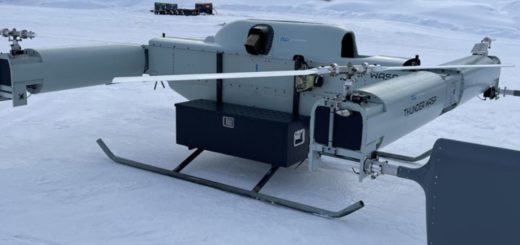US Marine Corps modernizes 360 MV-22B Osprey tiltrotor aircraft to keep them in service until the 2050s

{loadposition bannertop}
{loadposition sidebarpub}
Released on January 29, 2025, the 2025 Marine Corps Aviation Plan outlines modernization efforts for the MV-22B Osprey fleet, focusing on fleet restructuring, safety improvements, technological upgrades, and long-term sustainment. Over the past decade, the MV-22 has recorded a Class A mishap rate of 3.15 per 100,000 flight hours, lower than the Marine Corps’ average of 3.24 and below that of four other Marine Corps aircraft. The program includes 360 MV-22s across 16 active squadrons, two reserve squadrons, a fleet replacement squadron, an executive transport detachment, an operational test detachment, and a developmental test detachment.Follow Army Recognition on Google News at this link
Since its first deployment in 2007, the MV-22 fleet has conducted 109 operational deployments and logged over 588,000 flight hours, with each aircraft flying more hours per year than any other Marine Corps rotary-wing platform. (Picture source: US Marine Corps)
The MV-22 Osprey is a tiltrotor aircraft used by the U.S. Marine Corps, U.S. Air Force, and U.S. Navy, with Japan also operating the platform within its Ground Self-Defense Force. It replaced the CH-46 Sea Knight for the Marine Corps and has been in combat service since 2007. It uses two Rolls-Royce-Allison AE1107C turboshaft engines and can achieve speeds of 445 km/h with a range of 926 km. It is armed with an M2 .50 caliber machine gun and has a crew of four, including a pilot, copilot, and two flight engineers. The aircraft can transport up to 24 troops or cargo and is used for various operational roles.
Since its first deployment, the MV-22 has been used in Marine Air-Ground Task Force (MAGTF) operations, performing medium-lift assault missions. It operates from expeditionary locations and amphibious platforms, featuring aerial refueling capabilities. The fleet has conducted 109 operational deployments and logged over 588,000 flight hours, with each aircraft flying more hours per year than any other Marine Corps rotary-wing platform.
MV-22Bs stationed in Djibouti, Hawaii, and Okinawa support mobility in Africa, Asia, and the Indo-Pacific, contributing to crisis response, contingency operations, and humanitarian missions. The US Marine Corps considers the medium-lift transition complete, with 15 active and two reserve squadrons in service. Marine Medium Tiltrotor Squadron 264 (VMM-264) is planned for reactivation in FY26, with initial operational capability by FY27.
Modernization efforts prioritize safety, sustainment, and interoperability. Upgrades to the drive system—responsible for transmitting power—are under consideration to improve performance and reliability, potentially incorporating new engines or core components. The Osprey Drive System Safety and Health Instrumentation (ODSSHI) program will enable predictive maintenance by monitoring drivetrain components. The V-22 Enhanced Cockpit Technology Replacement (VeCToR) is addressing obsolescence issues and future avionics upgrades. The V-22 Fleet Optimization and Reduction of Configuration Effort (V-FORCE) standardizes fleet configurations and upgrades mission computers to improve digital interoperability.
The modernization program includes 360 MV-22s across 16 active squadrons, two reserve squadrons, a fleet replacement squadron, an executive transport detachment, an operational test detachment, and a developmental test detachment. (Picture source: US Marine Corps)
Structural modifications are being implemented to improve MV-22B reliability. Tailored Nacelle Improvements (TNI) include updates to wiring materials, harness designs, and connectors to enhance maintainability and availability. A new flight control computer will replace the existing system, incorporating automation and augmentation features. To improve safety during operations in low-visibility conditions, enhancements are being made to the aircraft’s systems to assist pilots in navigating through dust, fog, or darkness.
These enhancements to degraded visual environment (DVE) flight capabilities will improve handling and reduce pilot workload in low-visibility conditions. Additional efforts include the potential integration of modern electronic warfare systems, as well as survivability enhancements, digital interoperability improvements via the MAGTF Agile Network Gateway Link (MANGL), and integration of mission kits such as Network On The Move-Airborne (NOTM-A) and Intrepid Tiger-II Block V V4.
To optimize fleet readiness, the Marine Corps has reduced the number of unique aircraft configurations, consolidated Primary Aircraft Authorization (PAA) per squadron, and implemented inventory management strategies, including the MV Inventory Management (MVIM) and V-FORCE programs. In the past two years, unique fleet configurations have been cut by 50%, while squadron inventory has decreased from 12 to 10 aircraft, aligning with the Force Design framework.
Safety improvements include enhancements to the Proprotor Gearbox (PRGB), a critical component that transfers power from the engines to the rotors. Recent incidents exposed weaknesses in the PRGB’s metal gears, prompting new safety guidelines and planned replacements with more durable versions. The integration of an ODSSHI sensor will provide real-time vibration data, enabling predictive maintenance. Triple-Melt steel is being introduced to improve material integrity and reduce defects in gears and bearings. A redesigned Input Quill Assembly (IQA) is in development to address wear issues linked to previous Hard Clutch Engagement (HCE) incidents.
The Marine Corps’ Renewed V-22 Aircraft Modernization Plan (ReVAMP) aims to extend the aircraft’s service life by potentially replacing major structural components, such as wings and engine nacelles. These upgrades would keep the Osprey operational into the 2050s and beyond, until the Next Generation Assault Support (NGAS) aircraft is introduced.
Efforts will remain directed at aircraft readiness, survivability, and mission flexibility, with an emphasis on digital interoperability, sensor package integration, and expanded mission kit implementation. While the MV-22B remains a primary aviation platform for Marine Expeditionary Units (MEU) and Marine Air-Ground Task Force (MAGTF) operations, the NGAS initiative is expected to guide future medium-lift assault transport developments. Upgrades and sustainment efforts will ensure the MV-22B remains operational until a transition plan for NGAS is established.

{loadposition bannertop}
{loadposition sidebarpub}
Released on January 29, 2025, the 2025 Marine Corps Aviation Plan outlines modernization efforts for the MV-22B Osprey fleet, focusing on fleet restructuring, safety improvements, technological upgrades, and long-term sustainment. Over the past decade, the MV-22 has recorded a Class A mishap rate of 3.15 per 100,000 flight hours, lower than the Marine Corps’ average of 3.24 and below that of four other Marine Corps aircraft. The program includes 360 MV-22s across 16 active squadrons, two reserve squadrons, a fleet replacement squadron, an executive transport detachment, an operational test detachment, and a developmental test detachment.
Follow Army Recognition on Google News at this link
Since its first deployment in 2007, the MV-22 fleet has conducted 109 operational deployments and logged over 588,000 flight hours, with each aircraft flying more hours per year than any other Marine Corps rotary-wing platform. (Picture source: US Marine Corps)
The MV-22 Osprey is a tiltrotor aircraft used by the U.S. Marine Corps, U.S. Air Force, and U.S. Navy, with Japan also operating the platform within its Ground Self-Defense Force. It replaced the CH-46 Sea Knight for the Marine Corps and has been in combat service since 2007. It uses two Rolls-Royce-Allison AE1107C turboshaft engines and can achieve speeds of 445 km/h with a range of 926 km. It is armed with an M2 .50 caliber machine gun and has a crew of four, including a pilot, copilot, and two flight engineers. The aircraft can transport up to 24 troops or cargo and is used for various operational roles.
Since its first deployment, the MV-22 has been used in Marine Air-Ground Task Force (MAGTF) operations, performing medium-lift assault missions. It operates from expeditionary locations and amphibious platforms, featuring aerial refueling capabilities. The fleet has conducted 109 operational deployments and logged over 588,000 flight hours, with each aircraft flying more hours per year than any other Marine Corps rotary-wing platform.
MV-22Bs stationed in Djibouti, Hawaii, and Okinawa support mobility in Africa, Asia, and the Indo-Pacific, contributing to crisis response, contingency operations, and humanitarian missions. The US Marine Corps considers the medium-lift transition complete, with 15 active and two reserve squadrons in service. Marine Medium Tiltrotor Squadron 264 (VMM-264) is planned for reactivation in FY26, with initial operational capability by FY27.
Modernization efforts prioritize safety, sustainment, and interoperability. Upgrades to the drive system—responsible for transmitting power—are under consideration to improve performance and reliability, potentially incorporating new engines or core components. The Osprey Drive System Safety and Health Instrumentation (ODSSHI) program will enable predictive maintenance by monitoring drivetrain components. The V-22 Enhanced Cockpit Technology Replacement (VeCToR) is addressing obsolescence issues and future avionics upgrades. The V-22 Fleet Optimization and Reduction of Configuration Effort (V-FORCE) standardizes fleet configurations and upgrades mission computers to improve digital interoperability.

The modernization program includes 360 MV-22s across 16 active squadrons, two reserve squadrons, a fleet replacement squadron, an executive transport detachment, an operational test detachment, and a developmental test detachment. (Picture source: US Marine Corps)
Structural modifications are being implemented to improve MV-22B reliability. Tailored Nacelle Improvements (TNI) include updates to wiring materials, harness designs, and connectors to enhance maintainability and availability. A new flight control computer will replace the existing system, incorporating automation and augmentation features. To improve safety during operations in low-visibility conditions, enhancements are being made to the aircraft’s systems to assist pilots in navigating through dust, fog, or darkness.
These enhancements to degraded visual environment (DVE) flight capabilities will improve handling and reduce pilot workload in low-visibility conditions. Additional efforts include the potential integration of modern electronic warfare systems, as well as survivability enhancements, digital interoperability improvements via the MAGTF Agile Network Gateway Link (MANGL), and integration of mission kits such as Network On The Move-Airborne (NOTM-A) and Intrepid Tiger-II Block V V4.
To optimize fleet readiness, the Marine Corps has reduced the number of unique aircraft configurations, consolidated Primary Aircraft Authorization (PAA) per squadron, and implemented inventory management strategies, including the MV Inventory Management (MVIM) and V-FORCE programs. In the past two years, unique fleet configurations have been cut by 50%, while squadron inventory has decreased from 12 to 10 aircraft, aligning with the Force Design framework.
Safety improvements include enhancements to the Proprotor Gearbox (PRGB), a critical component that transfers power from the engines to the rotors. Recent incidents exposed weaknesses in the PRGB’s metal gears, prompting new safety guidelines and planned replacements with more durable versions. The integration of an ODSSHI sensor will provide real-time vibration data, enabling predictive maintenance. Triple-Melt steel is being introduced to improve material integrity and reduce defects in gears and bearings. A redesigned Input Quill Assembly (IQA) is in development to address wear issues linked to previous Hard Clutch Engagement (HCE) incidents.
The Marine Corps’ Renewed V-22 Aircraft Modernization Plan (ReVAMP) aims to extend the aircraft’s service life by potentially replacing major structural components, such as wings and engine nacelles. These upgrades would keep the Osprey operational into the 2050s and beyond, until the Next Generation Assault Support (NGAS) aircraft is introduced.
Efforts will remain directed at aircraft readiness, survivability, and mission flexibility, with an emphasis on digital interoperability, sensor package integration, and expanded mission kit implementation. While the MV-22B remains a primary aviation platform for Marine Expeditionary Units (MEU) and Marine Air-Ground Task Force (MAGTF) operations, the NGAS initiative is expected to guide future medium-lift assault transport developments. Upgrades and sustainment efforts will ensure the MV-22B remains operational until a transition plan for NGAS is established.





